Papers by Petri Ahokangas
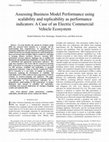
IEEE transactions on engineering management, 2024
In recent decades, the concept of a business model (BM) has attracted much attention as a strateg... more In recent decades, the concept of a business model (BM) has attracted much attention as a strategic tool for understanding firm competitiveness. As organisations face increasing complexities and uncertainties, assessing performance of BMs has become increasingly important for understanding how firms can leverage their strengths, address weaknesses, and adapt to changing industry dynamics. However, assessing BMs' performance presents inherent challenges due to multifaceted dimensions and quantification complexities, as well as the absence of well-defined and appropriate performance indicators. This study thus responds to the recent calls for research on assessing BMs' performance by proposing an assessment framework using two BM outcomes, scalability and replicability, as potential performance indicators. Using an Electric Commercial Vehicle (ECV) ecosystem as a case study, we employ an assessment framework, exploring the determinants of scalability and replicability in ECV BMs, which are then categorised as technical, economic (or business-oriented), and regulatory. This paper contributes to the emerging BM literature by proposing scalability and replicability as two performance indicators for a comprehensive understanding of BM performance. It further illuminates both concepts of scalability and replicability, concluding with practical implications for managers designing scalable and replicable BMs.
Springer eBooks, Oct 17, 2023
Springer eBooks, Oct 17, 2023
Springer eBooks, Oct 17, 2023
Alles war Märchen, alles war um eine Dimension reicher, um eine Bedeutung tiefer, war Spiel und S... more Alles war Märchen, alles war um eine Dimension reicher, um eine Bedeutung tiefer, war Spiel und Symbol.
Springer eBooks, Oct 17, 2023
Springer eBooks, Oct 17, 2023
The intersection of law, politics, and technology is going to force a lot of bright thinking.
Springer eBooks, Oct 17, 2023
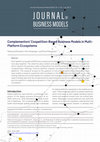
Journal of Business Models, May 25, 2023
Multi-platform ecosystems (MPEs) are comprised of multiple platforms integrated to create and cap... more Multi-platform ecosystems (MPEs) are comprised of multiple platforms integrated to create and capture value together. The collective value creation and capture within MPEs gives rise to coopetion, which impacts the business model configurations for both incumbents and entrants that provide complementary offerings. Previous platform research has predominantly focused on incumbent platforms. This research focuses on the question of how entrant platforms configure their business models to endorse coopetition with incumbents in the MPEs within the healthcare sector. Our findings indicate that entrant platforms configure their business models to integrate into MPEs and need to flexibly align with the complementarity requirements set by the incumbents, combine interand intra-platform collaborative dynamics in their business models, and build on coopetition with incumbents.

Data and connectivity platforms play a key role in the digitalization of different sectors of our... more Data and connectivity platforms play a key role in the digitalization of different sectors of our society. The availability of new services that are specialized to the needs of a given vertical sector in a specific location can significantly boost the business opportunities of that ecosystem. 5G in particular is aiming at offering new building blocks to digitalization by enabling fast exchange of increasing amounts of data between different entities. This paper presents a case study of the digitalization of a port which presents an intriguing example of future 5G platform ecosystems. We identify the key stakeholders of the port ecosystem and characterize their interactions in the current situation. We depict and analyze alternative configurations for connectivity and data platforms encompassing centralized, hybrid and fragmented approaches. Finally, we propose three consecutive steps for managing the service roadmap of the converged connectivity and data platforms in the port: fragmented data-fragmented connectivity phase, fragmented data-hybrid connectivity phase and the optimally hybrid data-optimally centralized connectivity phase.
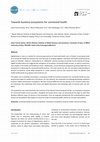
Finnish Journal of eHealth and eWelfare, May 21, 2017
Digitalisation is seen as a vehicle for restructuring practices of social and health care in Finl... more Digitalisation is seen as a vehicle for restructuring practices of social and health care in Finland. A conceptual model of connected health has evolved over time focusing on bringing together individuals and health professionals by means of 'eHealth', 'telecare', 'telemedicine' or 'telehealth' services and data connected via the Internet of Things. Digital transformation has triggered the emergence of innovative connected health services, as well as novel business models in the health and healthcare sector. Additionally, current literature emphasises growing importance of ecosystems in advancing the connected health business. The main reason for this, the increased understanding of business ecosystems would allow companies to create coherent services that would be easier for patients and health professionals (e.g. doctors and nurses) to use. This paper aims to develop and present a conceptual model for business ecosystem for connected health by mapping service needs for healthcare in the future. For this research, we conducted 16 meetings/workshops related to business models and business ecosystems. We also involved different end-user groups in our research (seven doctor interviews, four workshops with nurses and digital discussions and workshops with 12 parents with sick children). This qualitative case study illustrates the construct of the Nordic Central Hospital test lab-an innovation ecosystem for connected health service providers. Alongside the broad service map, we demonstrate the logic of value flow between different layers of services in the ecosystem. From an originality perspective, this multidisciplinary paper focuses on the pediatric day surgery to check the scope of connected health, which has not been done before.

The exponential growth of wireless services with diversity of devices and applications depending ... more The exponential growth of wireless services with diversity of devices and applications depending on connectivity has inspired the research community to come up with novel concepts to improve the efficiency of spectrum use. Recently, several spectrum sharing system concepts have been introduced and widely researched to cope with spectrum scarcity, though, to date, only a few have reached the policy and standardization phase. Moreover, only a subset of these concepts has gained industry interest with pre-commercial deployments and lucrative business model characteristics. This paper analyzes sharing economy business antecedent factors of the three topical regulatory approaches for spectrum sharing: global TV White Space (TVWS), Licensed Shared Access (LSA) from Europe, and Citizens Broadband Radio Service (CBRS) from the US. A comparison is made between these concepts to identify similarities and differences for developing a successful scalable sharing concept. Key factors for a sharing economy enabled scalable business model are introduced including platform, reduced need for the ownership, leverage of underutilized assets, adaptability to different policy regimes, trust, and value orientation. The results indicate that all analyzed sharing concepts meet basic requirements to scale, TVWS radically lowering entry barrier, LSA leveraging key existing assets and capabilities of mobile network operators, and CBRS extending the business model dynamics. The Sharing Economy provides a dynamic framework for analyzing and developing the spectrum sharing business models.
Developing products, services and vertical applications for the future digitized society in the 6... more Developing products, services and vertical applications for the future digitized society in the 6G era requires a multidisciplinary approach and a re-imagining of how we create, deliver and consume network resources, data and services. This development will change the traditional business models and ecosystem roles, as well as open the market for new stakeholders like micro-operators, cloud operators and resource brokers. Paper discusses unprecedented opportunities of enabling and stimulating multiple stakeholders to have a more active participation in the future 6G ecosystem via platform-based ecosystemic business models. The research extends the product platform and service modularity concepts beyond connectivity innovations towards multisided transactional ecosystem platforms.
Springer eBooks, 2018
This paper tackles today's unprecedented challenges of enabling and stimulating multiple energy s... more This paper tackles today's unprecedented challenges of enabling and stimulating multiple energy stakeholders to have a more active participation in the smart grid electricity market. The research extends the existing four archetypes of orchestrator-driven business models for the electricity market and proposes a fifth type of electricity market, the Blockchain Marketplace. The key novelty of the paper is to expand the electricity market architecture and design from centralization and pseudo-decentralization to full decentralization, enabled by the blockchain. The study not only broadens the smart grid and electricity market literature but also contributes to the theoretical development of the business model and organization study domains with a systemic approach.
Electric Power Systems Research, Oct 1, 2021
Abstract This paper focuses on the evolution of the Finnish power grid until 2035 and the role of... more Abstract This paper focuses on the evolution of the Finnish power grid until 2035 and the role of mobile communications networks in this evolution. It outlines alternative futures (i.e. scenarios) and identifies the role of mobile communications networks in these scenarios. The paper uses an established scenario planning process and a group of experts to determine three scenarios for the evolution of services offered to customers in a future electricity system and four scenarios describing the evolution of grid management. Finally, the role of mobile communications (cellular networks) is analyzed in each of the scenarios. Results show that mobile networks can serve as a key enabler in those scenarios where smart grid evolution would be the most transformative.
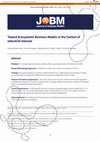
Journal of Business Models, Oct 23, 2016
Purpose: This study explores business models within a particular domain of Industrial Internet. D... more Purpose: This study explores business models within a particular domain of Industrial Internet. Design/Methodology/Approach: Building from theory, this study is conceptual in nature. Findings: This paper presents a business model framework for understanding the dynamics of value co-creation and co-capture from lifecycle and ecosystem configuration point of view. Research limitations/implications: This study stresses the need to understand how the integrated, co-dependent processes of value co-creation and co-capture influence on business models of individual firms in co-evolving business ecosystems. Practical implications: To fully benefit from the mutually connected opportunities enabled by IoT, it is important for firms to position themselves within the ecosystem in terms of the stage of product or service life cycle as well as the scale and scope of ecosystem configuration. Originality/value: The originality of this research thus relates to expanding the business model literature from ecosystemic perspective.

IEEE Wireless Communications, Apr 1, 2014
ABSTRACT Spectrum sharing between an existing incumbent spectrum user and an LTE/LTEAdvanced netw... more ABSTRACT Spectrum sharing between an existing incumbent spectrum user and an LTE/LTEAdvanced network with conditions that resemble exclusive licensing have become an appealing solution for mobile network operators to respond to the growing traffic and spectrum demand in a timely manner. While traditional exclusive licensing continues to be the preferred option for MNOs, the new sharing- based licensed shared access (LSA) concept is receiving growing interest in research, regulation and standardization. When applied to mobile communications, the LSA concept would allow an MNO to share spectrum from another type of incumbent spectrum user under a regulator??s supervision with predetermined rules and conditions that guarantee operational certainty for both MNO and incumbent. This article reviews different types of spectrum bands for LTE/LTE-Advanced and beyond networks, and focuses on the LSA concept as a spectrally efficient solution for spectrum access in the future. The article identifies the key stakeholders, including the incumbent spectrum user, the MNO, and the regulator, and their roles in the LSA concept. The key elements in the LSA concept are reviewed, and a work flow for the life cycle of the LSA concept is proposed, consisting of LSA preparation, licensing, deployment, and release phases. The tasks of the key stakeholders in the different phases of the LSA work flow are discussed. The LSA concept can offer a complementary approach to traditional exclusive licensing and license-exempt operations with features that benefit all involved stakeholders. It can be realized with reasonable modifications to the existing network infrastructure and regulatory framework with two new elements for managing the varying spectrum availability: the LSA Repository and LSA Controller.
IEEE Communications Magazine, Feb 1, 2023
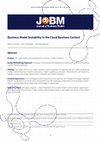
Purpose: The paper explores the antecedents to business model scalability. Design/Methodology/App... more Purpose: The paper explores the antecedents to business model scalability. Design/Methodology/Approach: The paper is conceptual and exploratory in nature and builds on the practice / action learning approach. Findings: The paper presents an action research based framework for approaching and understanding the change needs of business models and business model scalability as practices. These practices are based on a literature review of business opportunities, scalability and market dynamics. Practical Implications: From a managerial and entrepreneurial perspective, the findings of the paper highlight the role and dynamism of the business environment and the continuous assessment of the business environment in evaluating business opportunity and changes in opportunity. Originality/Value: The paper proposes a novel framework for business model synchronization against business opportunity, and vice versa. It also connects the business model to the market and hence to the market value of the firm.
IEEE Communications Magazine, Jul 1, 2023
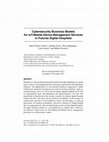
Journal of ICT standardisation, 2017
Hospitals as critical infrastructures has been historically dependent on various types of devices... more Hospitals as critical infrastructures has been historically dependent on various types of devices and equipment that are being revolutionized with digitalized solutions. The digitalization of conventional healthcare equipment is added with the new inclusion of numerous new devices for data collection, analysis, communication, and so on. All in all, the futures digital hospitals in 5G will be exponentially more data-dependent and digital-intensive. For that, this paper looks to theorize how the security scenario in a futures digital hospital would look like, and what relevant business possibilities could emerge for cybersecurity providers in the healthcare context. In this paper, we open up discussions on business possibilities relevant to Internet of Things-mobile device management for critical infrastructures such as future digital hospital. We apply business models as a conceptual lens to analyze how cybersecurity business could evolve for 5G enabled IoT-Mobile device management providers as a cybersecurity vendor.










Uploads
Papers by Petri Ahokangas